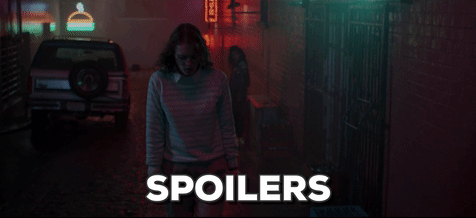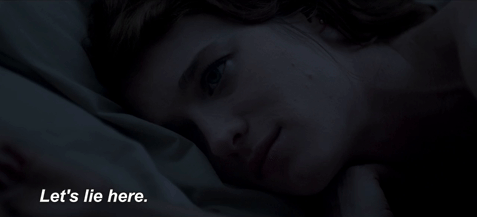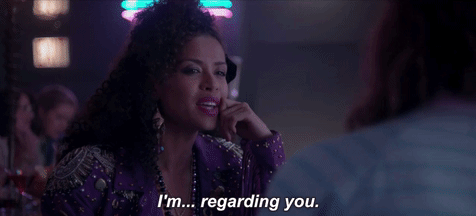
Black Mirror
Courtesy of Netflix.
Inside “San Junipero,” Black Mirror’s Uncharacteristically Beautiful Nostalgia Trip
Charlie Brooker and Gugu Mbatha-Raw explain the choice to focus on a same-sex couple without giving them a tragic end.
by LAURA BRADLEY
OCTOBER 28, 2016 9:00 AM
OCTOBER 28, 2016 9:00 AM
“San Junipero” is not your typical Black Mirror episode. The sunny installment in Charlie Brooker’s typically gray, murky dystopia has no sense of foreboding. There’s no dubious technical advance threatening to destroy anyone’s life as she knows it. There’s just a beautiful love story, heartwarmingly portrayed by Gugu Mbatha-Raw and Mackenzie Davis. The episode has been lauded not only as one of Black Mirror’s most accomplished yet, but also as a rare find among TV offerings in general: a story starring a same-sex couple that doesn’t end in pure tragedy.
Brooker said that in writing “San Junipero” he aimed “to upend the notion of what a Black Mirror episode was.” The show started out with the goal of telling a wide variety of stories, after all.
“I’d read some people going, ‘Oh, it’s going to Netflix; it’s all going to be American now. It’s all going to be little kids playing baseball.’ And I thought, Ah, fuck you, then, O.K. California. Haha!,” Brooker said with a laugh.
Brooker and Mbatha-Raw sat down with Vanity Fair to discuss the episode, Brooker’s choice to focus on two women, and what it was like to bring the story to life. But before you read on, make sure you’ve seen the episode. Spoilers a-plenty ahead.
For all of its uncharacteristic elements—the sunny atmosphere, the portrayal of a hopeful, positive use of technology, the period setting—most fans have fallen in love with “San Junipero” because of one thing: its refreshingly casual, magnetic portrayal of a same-sex couple.
It’s still pretty rare these days to see same-sex couples on TV, let alone female same-sex couples. But even when lesbians and other queer women make it on-screen, they tend to get killed off or treated as tragic figures. So it’s no wonder that the episode, in which both women technically die but also become immortal together, has already attracted a small cult of fans. The funny thing is, Brooker initially imagined the starring couple as heterosexual. His reason for making the change? Let’s just say we hope the rest of Hollywood’s screenwriters are taking notes.
“It was another decision where I just thought, Well, O.K., let’s question that. Is that the best version of this we could do?” Brooker said, adding later, “I wasn’t consciously reacting to other things in the culture, so much as thinking, This makes it a more interesting story.”
It’s this kind of thinking that could probably lead to the best L.G.B.T.Q. representation—or really diverse representation in general—in media going forward. It’s perhaps also worth noting that Mbatha-Raw’s and Davis’s characters, Kelly and Yorkie, are also an interracial couple—and, as the twist reveals, that they’re actually elderly women. (Brooker noted that there’s a subversive element, too, in depicting two (internally) elderly women “having loads of sex.”)
The two actually meet thanks to nostalgia therapy—in a kind of virtual-reality version of Second Life, where they can play in the simulated beach town San Junipero—in whatever year they want. When they die, they can each choose to either die as normal or “pass over,” uploading their consciousness and living in San Junipero permanently. In the end, they both choose the latter.
Another refreshing part of the episode is how well written Kelly and Yorkie both are. Their sexualities do not define them or their stories. “That’s what I thought was beautiful about the episode,” Mbatha-Raw said, “that it transcends any labeling. It’s really about human beings being human beings in love. And I think that, hopefully, we’re at that place now. Things don’t have to be an ‘issue.’ You know, it’s nice to see people just being who they are.”
And indeed, the storytelling possibilities for a time-hopping lesbian couple do seem more profound. For instance, the two can get married in the San Junipero version of 1987—which would have been legally impossible in the real 1987.
“That felt much richer,” Brooker said. “And then, I don’t know, I just sort of really liked the characters so much, I thought, Well, let’s just give them the happiest ending I can think of.”
Usually, Black Mirror episodes tend to, as Brooker put it, “power down at 200 miles an hour towards Dark Town.” But “San Junipero” ends with Kelly and Yorkie getting married and permanently passing over—driving into the sunset to the winking tune of “Heaven Is a Place on Earth.”
And so, somehow, Black Mirror—a show that usually teaches us to fear what technology can do in our own fallible hands—created one of the most gorgeous love stories of 2016. As always, there are some skeptics who will question that happy ending, but we’ll have none of that. This has been a very long year, and we all deserve to inhabit a world in which Kelly and Yorkie will live together for all eternity.






No comments:
Post a Comment